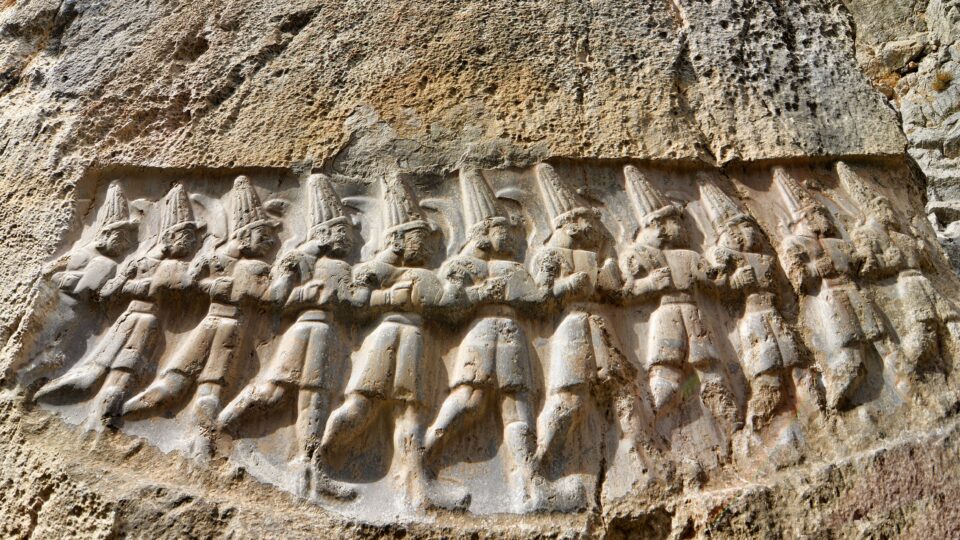A significant part of Türkiye’s cultural appeal lies in the traces of numerous civilisations that have ruled the Anatolian peninsula throughout history. A noteworthy component of this distinctive cultural mosaic was the powerful and influential Hittites, Anatolia’s first empire. With a legacy that includes the earliest known peace treaty and the first known love poem, the Hittites are considered one of the significant pillars of world history. The formidable Hittite empire extended throughout modern-day Anatolia, and the most remarkable Hittite ruins are within the boundaries of Çorum, a province in Türkiye’s Central Anatolia Region. The Hittite Trail, a less-explored hiking route in Türkiye, offers an opportunity to explore the historic settlements of the Hittite civilisation and learn about its rich cultural legacy. Throughout its 450-year reign, this mighty empire made numerous contributions to the history and culture of humanity.
Bronze Age Heritage of the Hittites: Alacahöyük
Spanning 385 kilometres, the Hittite Trail features 17 hiking trails spaced roughly 236 kilometres apart and six alternative routes, such as mountain bike trails. The major points on the route are Hattusa, the Hittite capital; Alacahöyük, the empire’s largest city; and Sapinuwa, Anatolia’s first military and administrative centre. Boğazkale-Hattusa-Sapinuwa, Alacahöyük-Alaca-Sapinuwa, and Boğazkale-Alacahöyük form the core of the trail. Lodging options such as well-equipped hotels, bungalow facilities, hostels, and camping sites are available along the trail in places like Alacahöyük, Boğazkale, and İncesu. Observations of wildlife and historical artefacts abound on the Hittite Trail, as do various stages of canyon trekking and, of course, Çorum-specific cuisine.
Alacahöyük, one of the three principal Hittite cities in Çorum, is the starting point for the Hittite Trail. One of Türkiye’s first national excavation sites and a must-visit spot for anyone with an interest in Bronze Age archaeology, the area has been inhabited for more than 6,000 years. Its treasures date back to the Hittite and Hattite periods and are considered to have produced the origins of Hittite culture. The Hittite settlement of Alacahöyük is notable for its extensive defence systems and imposing gates, which were constructed to thwart invasions. The Sphinx Gate is one of the city’s two main entrance gates, featuring towers, stone blocks, and carvings on the outer wall. In reality, the Sphinx Gate marks the entrance to a temple. The Temple Palace, which houses noteworthy storage chambers, and the Royal Tombs, renowned for their funeral gifts, are among the most significant findings at Alacahöyük. The Alacahöyük Museum displays artefacts discovered at Alacahöyük dating from the Chalcolithic, Old Bronze, Hittite, and Phrygian periods. A visit to the Museum of Anatolian Civilizations in Ankara is highly recommended, particularly if you want to know more about Alacahöyük. The museum houses some of the most significant finds from the site, including the original Sphinx Gate decorations and bronze sun courses – considered emblematic of Hittite civilisation and art – as well as a silver inlaid bronze deer statue, a burial gift discovered in the Royal Tombs; and a silver inlaid bronze bull figurine from the Hatti Period.
Ancient Hittite Capital: Hattusa
The next stop on the route is Hattusa, in the Boğazkale district. Referred to as the “City of a Thousand Gods” in many of the 30,000 clay tablets discovered at the site, Hattusa served as the capital of the Hittite civilisation for 450 years and is both a UNESCO World Cultural Heritage and on the UNESCO Memory of the World Register. The clay tablets include the extraordinary Kadesh Peace Treaty, the first-known recorded peace treaty; the tablets are now housed in the İstanbul Archaeological Museums — Museum of Ancient Oriental Art. Hattusa, which from a distance resembles an enormous stone puzzle set in greenery, is undoubtedly a remarkable open-air museum presenting the remains of temples, monumental gates, royal buildings, and city walls. One of its most important structures is the Great Temple, dedicated to the Storm God Teshub and the Sun Goddess Arinna. Magnificent monumental gates such as the Sphinx Gate and the King’s Gate, which provide entrances to the city, are also emblematic artefacts among the ruins.
Near the leading archaeological site of Hattusa is the Lions’ Gate, which reveals the advanced stone quality of the Hittite civilisation. Another notable structure nearby is the Yazılıkaya Open Air Temple. The area, with stellar examples of Hittite stone processing art, is worth visiting after your trip to Hattusa. It is also worth noting that the artefacts and remains excavated from the ancient city of Hattusa are exhibited in the Ankara Anatolian Civilisations Museum and the Boğazköy Museum.
Religious Centre of the Hittites: Sapinuwa
The last stop on the Hittite Trail is Sapinuwa. Set in today’s Ortaköy district, the city was an important military and religious centre during the Hittite era due to its political and geographical location. Sapinuwa is a comprehensive city, housing two temples built separately in the name of two Storm Gods and vital institutions such as the queen’s palace and the army command. In addition, nearly 4,000 Hittite cuneiform tablets were found in the city. The tablets, essential documents regarding the Hittite civilisation, are now part of the Çorum Archaeological Museum collection. While walking the Hittite road, you should visit Alaca Stream Valley and İncesu Canyon near Sapinuwa. Starting from the Gerdek Rock Tomb near Geven village, the valley extends to Cemilbey village. Rafting is another popular activity in the canyon.

